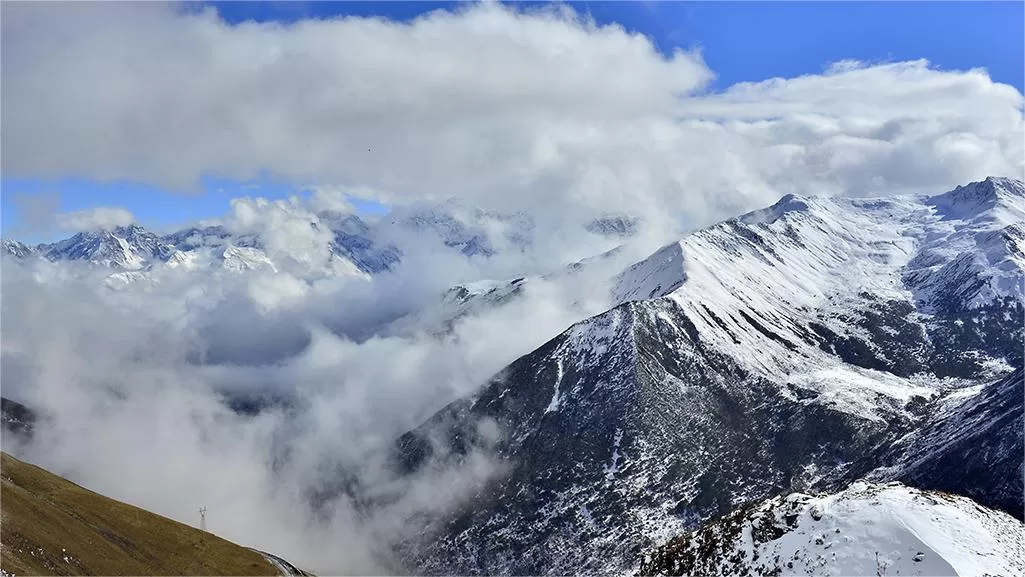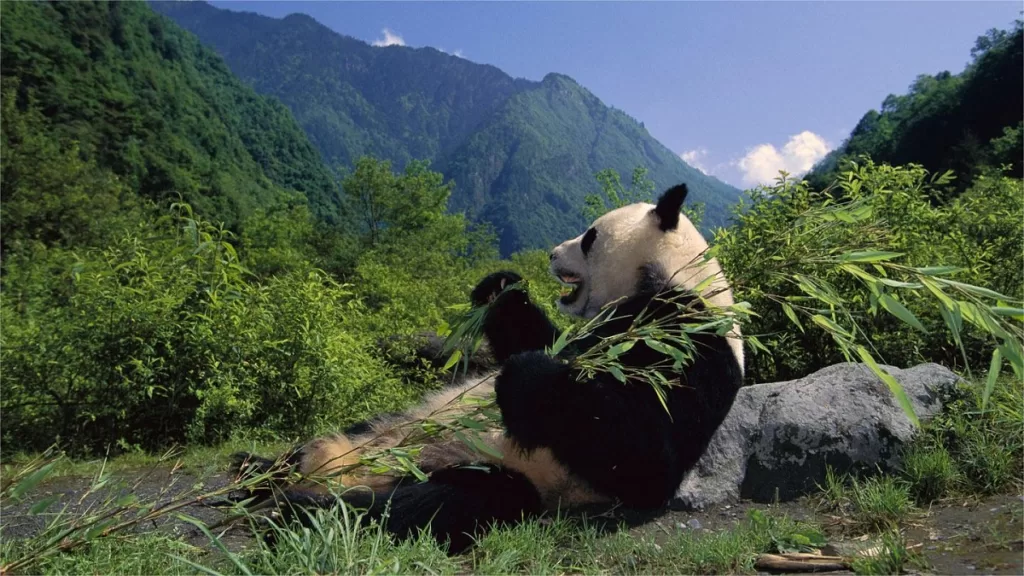Гора Сигунианг - цена билета, часы работы, расположение и основные моменты


Mount Siguniang (四姑娘山, Siguniang Mountain), also known as Four Sisters Mountain, is a majestic and awe-inspiring peak located in the Aba Tibetan and Qiang Autonomous Prefecture в провинции Сычуань, China. It is renowned for its stunning natural beauty and is often referred to as the “Queen of Sichuan’s Mountains.” The mountain range consists of four distinct peaks, resembling four graceful sisters standing side by side, hence the name. These peaks, known as Yaomei Peak, Ermei Peak, Sanmei Peak, and Dafeng Peak, reach elevations of over 5,000 meters, with Dafeng being the tallest.
Mount Siguniang offers a paradise for outdoor enthusiasts and nature lovers. Its picturesque landscapes include lush green forests, crystal-clear streams, and serene alpine meadows. The area is a haven for hikers, climbers, and photographers, offering a range of trails and routes catering to different skill levels. The region is also rich in biodiversity, with numerous rare plant and animal species, including the endangered giant panda, calling it home. The unique blend of stunning scenery and diverse wildlife makes Mount Siguniang a must-visit destination for eco-tourism and conservation efforts.
Whether you seek adventure, tranquility, or a spiritual connection with nature, Mount Siguniang offers a captivating experience that will leave you in awe of its natural splendor and charm.
Оглавление
- Основная информация
- Расположение и транспорт
- Altitude and Latitude
- Highlights of Mountain Siguniang
- Video about Mount Siguniang
- Полезные советы из подлинных отзывов
- Attractions near Mount Siguniang
Основная информация
| Сайт | https://www.sgns.cn/ |
| Предполагаемая продолжительность тура | День |
| Часы работы | 7.30 – 18.30; Last admission: 15.30 |
| Цена билета | 1st April – 30th November Shuangqiao Valley: 80 RMB Changping Valley: 70 RMB Haizi Valley: 60 RMB 1st December – 31st March the next year Shuangqiao Valley: 50 RMB Changping Valley: 50 RMB Haizi Valley: 20 RMB |
| Номер телефона | 0086-0837-2791999 0086-4006886250 |
Расположение и транспорт
Mount Siguniang is situated in the western part of Sichuan, near the border with the Tibetan Plateau. It lies approximately 220 kilometers west of Chengdu, the capital city of Sichuan Province. The mountain range is encompassed by the Siguniangshan National Nature Reserve, a protected area established to preserve its unique ecosystem and promote sustainable tourism.
To get to Mount Siguniang from Chengdu, you can take a coach at Chadianzi Bus Station (茶店子车站). It departs about every 1.5 hours and stops running after 14.00. Or you can rent a car at one of the car rental companies or travel agencies in Chengdu. It generally costs 500 – 1000 RMB. Remember! You need to get off at Mount Siguniang Stop or Rilong Stop instead of Xiaojin County, which is about 50 kilometers away.
Unfortunately, there is no high-speed train or flight to Mount Siguniang at the moment.
Altitude and Latitude
The approximate latitude of Mount Siguniang range falls between 31.033°N and 31.100°N. Its altitude varies depending on the specific peak. The highest peak in the range is Yaomei Peak, standing at an impressive elevation of approximately 6,250 meters (20,505 feet) above sea level. The other three peaks, namely Dafeng, Erfeng, and Sanfeng, have altitudes of around 5,025 meters (16,486 feet), 5,276 meters (17,310 feet), and 5,355 meters (17,570 feet), respectively. These towering heights make Mount Siguniang a challenging and rewarding destination for mountaineering enthusiasts.
Highlights of Mountain Siguniang
Da Gu Niang Mountain

Located at the southern edge of the Four Sisters Mountain Scenic Area, Da Gu Niang Mountain stands tall at an elevation of 5355 meters. Below 4000 meters, the landscape transforms into high mountain meadows dotted with wildflowers amidst shrubbery forests. Here, one can often spot yak and horses grazing freely, tended by local herdsmen. Wild mushrooms, as large as basin-sized, can be found in the lower regions, though they are elusive. Above 4000 meters, however, the terrain changes dramatically, characterized by barren rocky slopes devoid of vegetation, where even the toughest plants struggle to survive. During the summer, the mountain’s peak retains some snow, and snowfall occurs from October to April, with snow reaching knee-high depths in some areas.
Er Gu Niang Mountain

Adjacent to Da Gu Niang Mountain lies Er Gu Niang Mountain, boasting an elevation of 5454 meters. Comprising four mountains and three valleys, Er Gu Niang Mountain is situated at the border between Xiao Jin County and Wen Chuan County in the Aba Tibetan and Qiang Autonomous Prefecture. It represents one of the highest peaks of the Qionglai Mountain Range. In the summertime, lush greenery blankets the mountainside, offering glimpses of rare wildlife native to the Qinghai-Tibet Plateau and abundant medicinal herbs prized in Tibetan medicine. The peak of Er Gu Niang Mountain is characterized by its rugged, precipitous slopes and perpetually snow-capped summit, presenting a formidable challenge to climbers.
San Gu Niang Mountain

Located in the middle of the Four Sisters Mountain Scenic Area, San Gu Niang Mountain rises to an impressive height of 5355 meters, approximately 200 kilometers west of Chengdu. Renowned for its breathtaking scenery and rich biodiversity, the area is home to the world-famous giant pandas, making it a key site for the protection of these beloved animals. The peaks of San Gu Niang Mountain are characterized by their sharp, precipitous ridges and narrow, fortress-like summits, perpetually cloaked in snow. Within the scenic area lies the Wolong Nature Reserve, a vital research center dedicated to the conservation of giant pandas.
Yao Mei Peak

Standing at the northernmost edge of the Four Sisters Mountain Scenic Area, Yao Mei Peak boasts an elevation of 6250 meters, second only to the majestic Gongga Mountain, often referred to as the “King of Shu Mountains.” Known as the “Queen of Shu Mountains” or the “Eastern Holy Mountain,” Yao Mei Peak exudes an aura of sanctity and mystery, characteristic of many high mountain ranges. Some mountains earn their sacred status due to their geographic features, while others become revered for their religious significance or the tales of mountaineers’ exploits. Yao Mei Peak, part of the Four Sisters Mountain range, represents an eternal classic and a symbol of technical climbing prowess. It stands as a testament to the endurance and determination of climbers, offering them a choice between transcendence or defeat. Its rugged terrain bears the marks of elite climbers’ achievements as well as the tears shed by those who have failed. Only those with true courage and resolve can earn the honor of conquering its summit.
Shuangqiao Gully

Nestled in the northwest of the Four Sisters Mountain Scenic Area, Shuangqiao Gully spans 34.8 kilometers with an area of 216.6 square kilometers. Surrounded by towering peaks, this valley boasts diverse landscapes, from lush birch and poplar forests at lower elevations to spruce, fir, and hemlock forests higher up. The area is also adorned with extensive thickets of seabuckthorn, shrubs, and deciduous pines, creating a picturesque natural haven.
Changping Gully

Found in the northeast of the Four Sisters Mountain Scenic Area, Changping Gully stretches 29 kilometers over an area of approximately 100 square kilometers, ranking among the area’s primary attractions. In addition to its stunning natural scenery, Changping Gully is renowned for its distinctive Jiarong Tibetan ethnic culture. Visitors can explore highlights such as Zhangmu Tibetan Village, the Gelugpa Lama Temple, the ancient cypress avenue, the Dead Tree Beach, the Pure Heart Cave, the Bathing Pool, the Drum Stone, and the Golden Chicken Ridge.
Haizi Gully

Located in the eastern part of the Four Sisters Mountain Scenic Area, Haizi Gully earns its name, which translates to “Lake Gully,” from the numerous alpine lakes dotting its landscape. Spanning 19.2 kilometers and covering an area of 126.48 square kilometers, this valley features vast expanses of pristine grasslands. Serving as the source of the Zanla River, Haizi Gully is home to ancient fish species dating back to the Quaternary period, offering a glimpse into the region’s geological past. Key attractions within the gully include Guozhuangping, Dahai Lake, Huahai Lake, and Fuqi Lake.
Тибетская культура

The Tibetan culture of Mount Siguniang emanates a sense of timelessness and spiritual depth. The region is home to the Tibetan and Qiang ethnic groups, who have preserved their unique traditions for generations. Vibrant prayer flags flutter in the breeze, while ancient monasteries dot the landscape, emanating an aura of devotion and tranquility. Visitors can immerse themselves in the warm hospitality of the locals, witness colorful traditional festivals, and admire intricate Tibetan architecture. From the melodious chants of monks to the captivating rituals and rich symbolism, the Tibetan culture of Mount Siguniang offers a glimpse into a captivating world steeped in spirituality and tradition.
Video about Mount Siguniang
Полезные советы из подлинных отзывов
Preventing Altitude Sickness:
- Walk slowly to conserve energy and avoid excessive exertion.
- Refrain from consuming alcohol during your time at high altitudes.
- Consider carrying an oxygen cylinder when venturing out to prevent oxygen deficiency.
- Ensure adequate sleep, avoiding covering your head while sleeping.
- Avoid overeating or consuming oily foods, and refrain from excessive drinking or eating.
Местная кухня:
- Local delicacies are primarily found in Siguniang Town, with Tibetan and Sichuan restaurants available.
Climbing Seasons:
- For spectacular snow views of Mount Siguniang, the best times are autumn-winter (October to February) and spring snow season (March to May).
- Climbing success rates are highest from June to August when the mountain is in full bloom, with rich vegetation and higher oxygen levels.
Temperature on Mount Siguniang:
- Spring: Average temperatures can reach -10°C, with the clearest days around -2°C. Be prepared for significant temperature differences between day and night. Bring warm clothing, including down jackets, and sunglasses to shield your eyes from the glare of snow.
- Summer: Dress lightly during the day and use sun protection. Rain during the season may cool the temperatures, so bring windproof and warm clothing.
- Autumn: Dress in layers, with the ability to remove or add clothing as needed.
- Winter: Prepare for cold temperatures with layers for warmth and sun protection.
Characteristics of the Three Valleys:
- Shuangqiao Valley is primarily for sightseeing by car (35 km in total, best explored by a combination of car and walking). It is the most developed, offering diverse landscapes and the easiest route without horseback riding.
- Haizi Valley focuses on adventure tourism (19.2 km in total, best explored by horseback riding and walking), maintaining its original ecological state and attracting mountaineering enthusiasts.
- Changping Valley emphasizes eco-tourism (29 km in total, best explored by horseback riding and walking), being partially open and surrounded by pristine forests and canyons.
Attractions near Mount Siguniang

Гора Балан, Сычуань

Национальный природный заповедник Волонга

Тибетская деревня Цзячжу
Достопримечательности в Абе, Пейзажи Сычуани, Тибетская область Сычуань